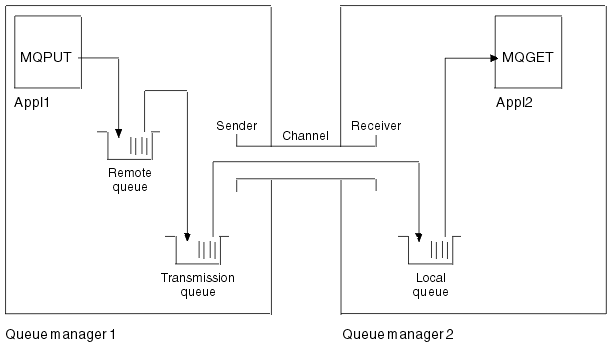Example configuration chapters in this book
Throughout the following parts of the book, there is a series of chapters containing examples of how to configure the various platforms to communicate with each other. These chapters describe tasks performed to establish a working WebSphere MQ network. The tasks were to establish WebSphere MQ sender and receiver channels to enable bi-directional message flow between the platforms over all supported protocols.
To use channel types other than sender-receiver, see the DEFINE CHANNEL command in WebSphere MQ Script (MQSC) Command Reference.
Figure 1 is a conceptual representation of a single channel and the WebSphere MQ objects associated with it.
Figure 1. WebSphere MQ channel to be set up in the example configuration chapters in this book
This is a simple example, intended to introduce only the basic elements of the WebSphere MQ network. It does not demonstrate the use of triggering which is described in Triggering channels.
The objects in this network are:
- A remote queue
- A transmission queue
- A local queue
- A sender channel
- A receiver channel
Appl1 and Appl2 are both application programs; Appl1 is putting messages and Appl2 is receiving them.
Appl1 puts messages to a remote queue. The definition for this remote queue specifies the name of a target queue manager, a local queue on that queue manager, and a transmission queue on this the local queue manager.
When the queue manager receives the request from Appl1 to put a message to the remote queue, it looks at the queue definition and sees that the destination is remote. It therefore puts the message, along with a transmission header, straight onto the transmission queue specified in the definition. The message remains on the transmission queue until the channel becomes available, which may happen immediately.
A sender channel has in its definition a reference to one, and one only, transmission queue. When a channel is started, and at other times during its normal operation, it will look at this transmission queue and send any messages on it to the target system. The message has in its transmission header details of the destination queue and queue manager.
The intercommunication examples in the following chapters describe in detail the creation of each of the objects described above, for a variety of platform combinations.
On the target queue manager, definitions are required for the local queue and the receiver side of the channel. These objects operate independently of each other and so can be created in any sequence.
On the local queue manager, definitions are required for the remote queue, the transmission queue, and the sender side of the channel. Since both the remote queue definition and the channel definition refer to the transmission queue name, it is advisable to create the transmission queue first.
Parent topic:
How intercommunication works
ic12100_
Home
